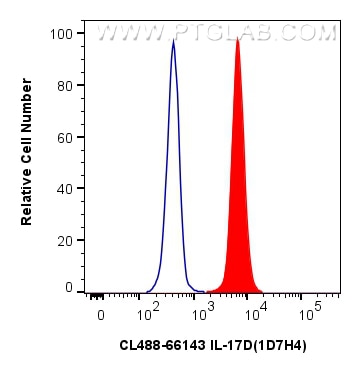Tested Applications
| Positive FC (Intra) detected in | human PBMCs |
Recommended dilution
| Application | Dilution |
|---|---|
| Flow Cytometry (FC) (INTRA) | FC (INTRA) : 0.25 ug per 10^6 cells in a 100 µl suspension |
| It is recommended that this reagent should be titrated in each testing system to obtain optimal results. | |
| Sample-dependent, Check data in validation data gallery. | |
Product Information
CL488-66143 targets IL-17D in FC (Intra) applications and shows reactivity with human samples.
| Tested Reactivity | human |
| Host / Isotype | Mouse / IgG2b |
| Class | Monoclonal |
| Type | Antibody |
| Immunogen |
CatNo: Ag6762 Product name: Recombinant human IL-17D protein Source: e coli.-derived, PET28a Tag: 6*His Domain: 1-202 aa of BC036243 Sequence: MLVAGFLLALPPSWAAGAPRAGRRPARPRGCADRPEELLEQLYGRLAAGVLSAFHHTLQLGPREQARNASCPAGGRPADRRFRPPTNLRSVSPWAYRISYDPARYPRYLPEAYCLCRGCLTGLFGEEDVRFRSAPVYMPTVVLRRTPACAGGRSVYTEAYVTIPVGCTCVPEPEKDADSINSSIDKQGAKLLLGPNDAPAGP Predict reactive species |
| Full Name | interleukin 17D |
| Calculated Molecular Weight | 22 kDa |
| Observed Molecular Weight | 28 kDa |
| GenBank Accession Number | BC036243 |
| Gene Symbol | IL-17D |
| Gene ID (NCBI) | 53342 |
| RRID | AB_3084213 |
| Conjugate | CoraLite® Plus 488 Fluorescent Dye |
| Excitation/Emission Maxima Wavelengths | 493 nm / 522 nm |
| Form | Liquid |
| Purification Method | Protein A purification |
| UNIPROT ID | Q8TAD2 |
| Storage Buffer | PBS with 50% glycerol, 0.05% Proclin300, 0.5% BSA, pH 7.3. |
| Storage Conditions | Store at -20°C. Avoid exposure to light. Stable for one year after shipment. Aliquoting is unnecessary for -20oC storage. |
Background Information
IL17D is a secreted cytokine with homology to the IL-17 family of proteins. IL17D is preferentially expressed in skeletal muscle, brain, adipose tissue, heart, lung, and pancreas. The treatment of endothelial cells with IL17D has been shown to stimulate the production of other cytokines including IL6, IL8 and CSF2/ GM-CSF. The increased expression of IL8 induced by IL17D was found to be NF-kappa B-dependent.
Protocols
| Product Specific Protocols | |
|---|---|
| FC protocol for CL Plus 488 IL-17D antibody CL488-66143 | Download protocol |
| Standard Protocols | |
|---|---|
| Click here to view our Standard Protocols |




